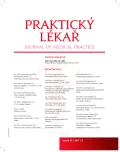Prostate cancer and secondary prevention in general practitioners’ offices
Authors:
Z. Kyselý 1; J. Ševčíková 1
; K. Azeem 1; H. Tomášková 2; J. Vlčková 1
; D. Horáková 1
; H. Kollárová 1
Authors‘ workplace:
Ústav preventivního lékařství, Lékařská fakulta Univerzity Palackého v Olomouci
Přednosta: doc. MUDr. Helena Kollárová, Ph. D.
1; Ústav epidemiologie a ochrany veřejného zdraví, LF OU v Ostravě
Přednosta: doc. MUDr. Rastislav Maďar, PhD., MBA, FRCPS
2
Published in:
Prakt. Lék. 2017; 97(5): 215-222
Category:
Of different specialties
Overview
Introduction:
The incidence of cancer in the Czech Republic has increasing trend. Prostate cancer has been among the most common malignant tumours in men since 2005. Testing PSA is not recognized as the official screening method, yet it’s frequently used.
Patients and methods:
Patients were obtained from the offices of 5 collaborating general practitioners from patients registered at these practitioners between 2002 and 2014. A general practitioner evaluated medical documentation of studied patients. The focus was on the early detection of prostate cancer and selected epidemiological characteristics in total of 1,601 men.
Results:
The mean age of men in the prostate cancer patients was 59.5 years and the median age was 61 years. In 48 men were found higher (n = 44) or borderline (n = 4) PSA levels. Of these 48 men, 13 were diagnosed with prostate cancer based on higher PSA levels. A total of 45 newly diagnosed prostate carcinomas were studied in the study.
Conclusion:
In spite of the increasing incidence of prostate cancer, we can see a decrease in mortality in recent years. This may be due to more frequent testing and advancements in the therapy. At present, diagnosis of the disease, in addition to the PSA, is based on the examination of the rectum and prostate biopsy. PSA is one of the major markers in the diagnosis and control of prostate cancer therapy. An active approach to preventive examinations is also important.
Keywords:
prostate cancer – epidemiology – PSA – prevention
Sources
1. Bhindi B, Xie WY, Kulkarni GS, et al. Influence of metabolic syndrome on prostate cancer stage, grade, and overall recurrence risk in men undergoing radical prostatectomy. Urology 2016; 93(105): 77–85.
2. Čapoun O. Karcinom prostaty. Česká urologická společnost ČLS JEP [on-line]. Dostupné z: http://www.cus.cz/pro-pacienty/diagnozy/karcinom-prostaty/ [cit. 2017-7-20].
3. Česká onkologická společnost ČLS JEP. Onkoprevence pro Českou republiku [online]. Dostupné z: https://www.linkos.cz/prevence-a-skrining/onkoprevence-pro-ceskou-republiku-1/ [cit. 2016-06-17].
4. Dušek L, Mužík J, Kubásek M, a kol. Epidemiologie zhoubných nádorů v České republice [online]. Masarykova univerzita, 2005. Dostupné z: http://www.svod.cz. Verze 7.0 [2007], ISSN 1802-8861. [cit. 2017-7-20].
5. Ferlay J, Soerjomataram I, Ervik M, et al. GLOBOCAN 2012 v1.0. Cancer incidence and mortality worldwide: IARC CancerBase No. 11 [Internet]. Lyon, France: International Agency for Research on Cancer; 2013. Available from: http://globocan.iarc.fr.
6. Hemminki K. Familial risk and familial survival in prostate cancer. World J Urol 2012; 30(2): 143–148.
7. Jones MR, Joshu CE, Kanarek N, et al. Cigarette smoking and prostate cancer mortality in four US states, 1999–2010. Prev Chronic Dis 2016; 13 : 150454.
8. Kolombo I, Poršová M, Zemanová I, a kol. Prostatický antigen (PSA) a digitální rektální vyšetření (DRE) v diagnostice karcinomu prostaty. Urolog pro praxi 2008; 9(2): 83–88.
9. Kopecký J, Povová J, Janout V. Přínos (-2)proPSA a PHI pro diagnostiku karcinomu prostaty. Urolog pro praxi 2015; 16(3): 106–108.
10. Král M, Vyhnánková V, Študent V, Bouchal J. Genetické riziko karcinomu prostaty. Ces Urol 2010; 14(3): 139–147.
11. Lima AR, Bastos Mde L, Carvalho M, Guedes de Pinho P. Biomarker discovery in human prostate cancer: an update in metabolomics studies. Trans Oncol 2016; 9(4): 357–370.
12. Lukeš M, Záleský M, Zachoval R, a kol. Prostatický specifický antigen a karcinom prostaty. Klin. onkol. 2011; 14(4): 114–118.
13. Ministerstvo zdravotnictví ČR. Vyhláška o preventivních prohlídkách č. 317/2016 Sb., která mění vyhlášku č. 70/2012 Sb.
14. Morávek P jr., Morávek P sen. Která vyšetření vedou k diagnóze karcinomu prostaty Urol praxi 2015; 16(5): 214–217.
15. Mužík J, Dušek L, Babjuk M, a kol. Uroweb – webový portál pro analýzu a vizualizaci epidemiologie, diagnostiky a léčby urologických malignit [online]. Masarykova univerzita, Brno, 2016. Dostupné z: http://www.uroweb.cz [cit. 2016-06-17].
16. Robinson JG, Hodges EA, Davison J. Prostate-specific antigen screening: a critical review of current research and guidelines. J Am Assoc Nurse Pract 2014; 26(10): 574–581.
17. Švihra J, jr. Nástroje hodnotiace kvalitu života u pacientov s karcinómom prostaty Urol praxi 2016; 17(4): 177–179.
18. UZIS Praha. Novotvary 2012-2013. [online]. Dostupné z: http://www.uzis.cz/node/7685 [cit. 2016-06-17].
19. UZIS Praha. Novotvary 2014 [online]. Dostupné z: http://www.uzis.cz/node/7686 [cit. 2016-06-17].
20. Valberg M, Grotmol T, Tretli S, et al. Prostate-specific antigen testing for prostate cancer: Depleting a limited pool of susceptible individuals? Eur J Epidemiol 2016; Jul 18.
21. Weiner AB, Matulewicz RS, Eggener SE, Schaeffer EM. Increasing incidence of metastatic prostate cancer in the United States (2004–2013). Prostate Cancer Prostatic Dis 2016; 19(4): 395–397.
Labels
General practitioner for children and adolescents General practitioner for adultsArticle was published in
General Practitioner

2017 Issue 5
- Metamizole vs. Tramadol in Postoperative Analgesia
- Advances in the Treatment of Myasthenia Gravis on the Horizon
- What Effect Can Be Expected from Limosilactobacillus reuteri in Mucositis and Peri-Implantitis?
- Hope Awakens with Early Diagnosis of Parkinson's Disease Based on Skin Odor
- Metamizole in perioperative treatment in children under 14 years – results of a questionnaire survey from practice
Most read in this issue
- Functional disorders of the musculoskeletal system
- Selected problems in female patients with relapsing-remitting sclerosis multiplex
- Honey and health
- European guide on good practices for Patient Blood Management
